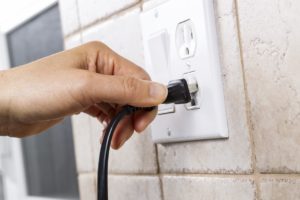Electrical outlets, just like other electrical fixtures, are susceptible to damage, malfunction, and wear and tear. Serious damage to outlets usually calls for their replacement. After all, the cost of an outlet replacement is often way below the cost of the damage the outlet can cause. The following are some of the telltale signs that may mean your outlets are due for a replacement.
The Outlet Is Cracked
A cracked electrical outlet is dangerous in more ways than one. First, water can easily get into the outlet, and since water conducts electricity, the water exposure can lead to a short circuit that can cause electrical fire or shock (or even electrocution if the outlet is high powered). The short-circuit may also trigger electrical faults in other parts of the circuit and cause damage.
Secondly, if the crack is large enough, a child can poke their finger or, even more likely, insert an object into the crack and experience an electrical shock. Pests may also get into the outlet and chew the insulation or cause a short circuit and its dangerous consequences.
The Holes Have Widened
An electrical plug should fit snugly into each outlet; an outlet has lost its usefulness and become dangerous if plugs hang loose or fall out when you insert them into the outlet. Such a situation occurs when normal wear or tear or damage has loosened the holes in the outlet.
A loose outlet is more than an inconvenience; the situation is dangerous. For example, a loose plug may lead to sparks, which may create electrical arcs and trigger an electrical fire. Replace your loose outlets before they get to that dangerous eventuality.
The Outlet Is Dead
A dead outlet is also useless. You may overcrowd other outlets or overload other short-circuits if one or more of your outlets are dead. Outlets die for several reasons, for example:
- Wire connections in the outlet have loosened.
- The outlet has burned due to overheating.
- The circuit is overloaded.
- The outlet has an electrical discontinuity problem.
- The outlet is damaged.
You may be able to replace an outlet if you can diagnose the problem and it is repairable. Something like loose wires, for example, is repairable. In many cases, however, the simplest solution is to replace the whole outlet.
The Outlets Is Burnt
You should replace a burnt outlet whether it still works or not. A burnt outlet has darkened or discolored areas around it or on the outlet cover itself. The outlet may also feel warm to the touch when you switch it on. In serious cases, some parts of the outlet may even melt.
Outlets typically burn when they malfunction or can’t handle the electricity you want to draw from them. For example, an outlet may burn if corrosion has affected it since corrosion increases electrical resistance that leads to overheating. The damage in a burnt outlet can only worsen with time so replace it before the worst happens.
The Outlets Is Inappropriate for the Area
Lastly, you should also replace an outlet if you find out that it is inappropriate for the area. For example, all outlets located near water (such as kitchen or bathroom outlets) should have ground-fault circuit interrupters (GFCI). GFCIs protects you from electrical injury or damage should it sense an electrical fault, such as a short circuit due to water exposure.
Before you replace an electrical outlet, consult an electrical contractor to diagnose the problem and advise you on whether a replacement is necessary. A to Z Electric Co. can do this for you and also help you diagnose other associated electrical problems. You should never postpone electrical problems; contact us the minute you notice a malfunction.

